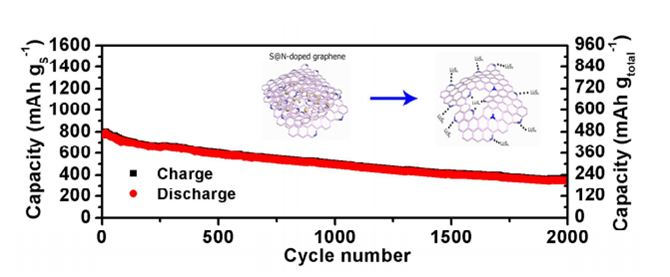Lithium/sulfur (Li/S) batteries have attracted considerable attention due to its great potential to deliver much higher specific energy than the current lithium-ion batteries. The theoretical specific capacity and energy density are as high as 1675 mA h g?1 and 2600 Wh kg?1, respectively. However, the poor intrinsic electrical conductivity of the active material, the high solubility of intermediate polysulfides into the electrolyte, and the large volumetric expansion of approximately 76% based on full transformation of sulfur to Li2S result in the low utilization of sulfur and the rapid capacity fading on cell cycling, which has hindered the further development of Li/S battery technology and its application.
To address these key issues, chemists and materials scientists have been trying to design and construct novel microstructured/nanostructured S cathode materials to improve cell performance. Graphene has emerged as one of the most promising conductive matrixes for Li/S batteries owing to its unique two-dimensional morphology, high specific surface area of over 2600 m2/g, superior electrical conductivity, and excellent structural stability.
Recently, ZHANG Yuegang’s group at the Suzhou Institute of Nano-Tech and Nano-Bionics discovered a simple, low-cost, and scalable method to prepare an additive-free nanocomposite cathode in which sulfur nanoparticles are wrapped inside nitrogen-doped graphene sheets (S@NG),which has significantly improved the cycle-life of Li/S cells. The results was published on《Nano Letters》as a communication article (DOI: 10.1021/nl5020475 http://pubs.acs.org/doi/pdf/10.1021/nl5020475). In the paper, they show that the Li/S@NG can deliver high specific discharge capacities at high rates, i.e. ~1167 mAh g-1 at 0.2 C, ~1058 mAh g-1 at 0.5 C, ~971 mAh g-1 at 1 C, ~802 mAh g-1 at 2 C, ~606 mAh g-1 at 5 C. The cells also demonstrate an ultra-long cycle life exceeding 2000 cycles and an extremely low capacity-decay rate (0.028% per cycle), which is among the best performance demonstrated so far for Li/S cells. Furthermore, the S@NG cathode can be cycled with an excellent Coulombic efficiency of above 97% after 2000 cycles. With a high active S content (60%) in the total electrode weight, the S@NG cathode could provide a specific energy that is competitive to the state-of-the-art Li-ion cells even after 2000 cycles. The X-ray spectroscopic analysis and ab-initio calculation results indicate that the excellent performance can be attributed to the well-restored C-C lattice and the unique lithium polysulfide binding capability of the N functional groups in the NG sheets. The results indicate that the S@NG nanocomposite based Li/S cells have a great potential to replace the current Li-ion batteries.
This work was supported by China Postdoctoral Science Foundation (No. 2014M550314) and the Natural Science Foundation of Jiangsu Province, China (No. BK20140383).

Figure: Nitrogen-doped graphene of high surface area, high electrical conductivity, and with highly-functional N-groups is a promising conductive matrix material for fabricating high-rate and ultra-long cycle-life Li/S batteries. (Image By SINANO)
downloadFile
